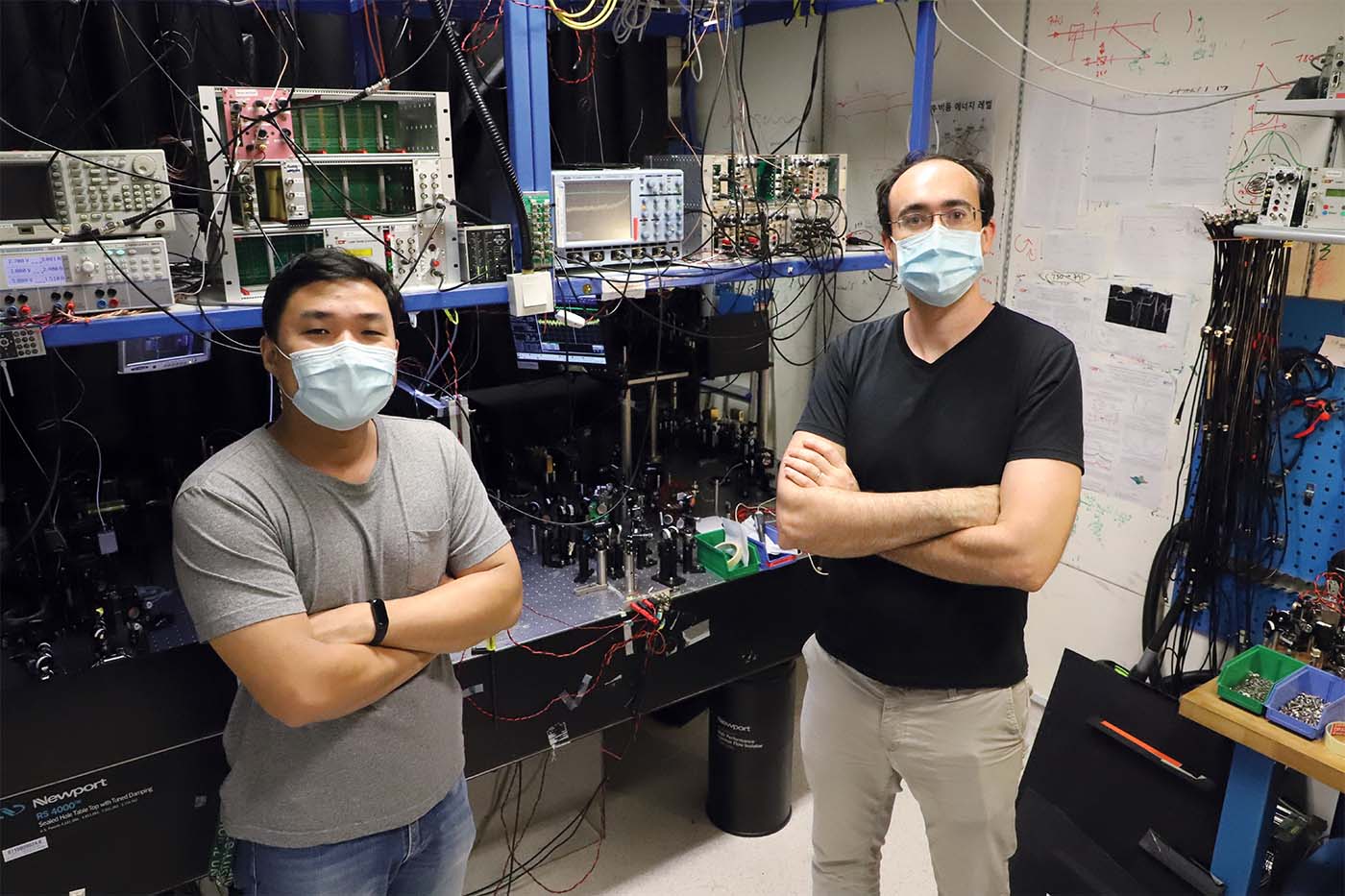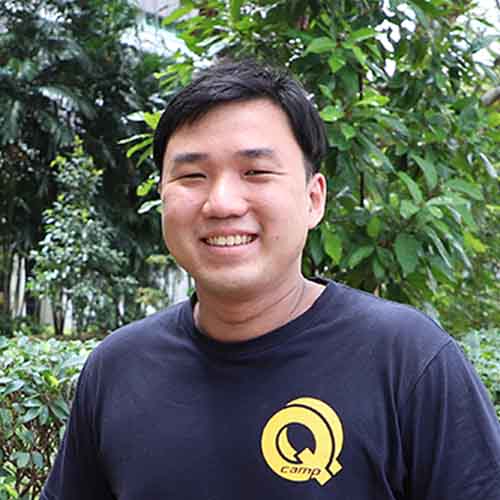Highlights
Match-making between photon and atom frequency could boost quantum network performance
 CQT PhD student Yeo Xi Jie (left) and CQT graduate Mathias Seidler (right) were part of the team that implemented a new method to compress single photons.
CQT PhD student Yeo Xi Jie (left) and CQT graduate Mathias Seidler (right) were part of the team that implemented a new method to compress single photons.
A CQT team has developed a novel technique to compress the frequency spread of single photons, making them a better match to the absorption preferences of atoms. This is a promising approach to make light-matter interactions in quantum technologies more efficient.
Interactions between light and matter form the basis of many schemes to store, process and relay quantum information. For example, photons might transmit data through a network while atoms store and process the data. The data transfers from one system to the other when an atom emits or absorbs a photon.
CQT’s Mathias Seidler, Yeo Xi Jie, Alessandro Cerè and Christian Kurtsiefer worked out how to use a resonant cavity and time-lenses to fine-tune the frequency of photons. In their work published in Physical Review Letters on 28 October, the team describe the results for experiments on single photons emitted from non-linear optical process in a cloud of cold rubidium atoms.
Even single photons have a spectral profile, a frequency distribution usually represented by a bell-shaped curve. The team reported a compression in the width of this curve for photons emitted by rubidium from 20.6 MHz to less than 8 MHz. This improves the match of these ‘narrowband’ photons to rubidium’s absorption profile, which is about 6 MHz.
Like the shape sorting toys children play with, when a block slides easily into the matching-shape hole, the photon is now the right shape to go into the atom. Previously, the group had also shown a way to shape the temporal profile of photons. This work is another step towards making the photon a perfect match for the atom.
Compressing light
In scientific terms, if the profiles of photon and atom don’t match, the interaction probability between the light and matter is low. This would decrease the performance of a quantum network, for example, because every failed absorption equates to lost data.
“The usual approach is to filter photons, selecting only those that match the properties we want. But this introduces photon loss, also reducing the quantum network performance,” says Mathias, who is the first author of the paper. Mathias is now a research engineer at S-Fifteen Instruments, a CQT spin-off developing quantum communication technology and advanced instrumentation, having graduated from CQT’s PhD programme in 2019.
The CQT team’s method puts the photons through two steps. Firstly, the photon passes through a device known as an asymmetric cavity that releases its component frequencies one after another, spreading them out in time. That light then enters an electro-optical modulator, which acts as a time-lens, applying different phase shifts to the frequencies arriving at different times.
Higher frequency blue light is redshifted to a lower frequency, and lower frequency red light is blueshifted to a higher frequency, pushing them closer to the central frequency. The result is that the photon is compressed.
No need for fibres to Mars
The main novelty was in using a resonant cavity to spread out the frequencies enough for the time-lens. “Conventionally spectral compression has been done using optical fibres for photons of larger bandwidths. But the amount of optical fibres we would need to compress the spectrum of the photons we are dealing with would span from here to Mars. We needed a different dispersive medium,” says Xi Jie.
Xi Jie, who is now a CQT PhD student, worked on this experiment for his final year project when he was a physics undergraduate in NUS. His report on the project recently won him an international undergraduate thesis award.
The team had built up experimental know-how in using a cavity to manipulate photons in their earlier work. Essentially, a cavity is made of two mirrors facing each other. The team’s cavity has one mirror that partially transmits light and one mirror with near 100% reflectivity. The light bounces back and forth between the two mirrors. Whether or not the light exits via the partially transmitting mirror or remains in the cavity depends on the interference conditions. If the reflected light is out of phase with the light entering the cavity, they cancel out and exit the cavity. If they are in phase, they constructively interfere and remain in the cavity. As a result, different frequencies of light exit the cavity at different times.
The immediate next step for the researchers would be to send the compressed photon to an atom to measure what difference the compression makes, checking if the atom absorbs the photon better.
Learn more
Related Stories
 | Shape matters when light meets atom December 02 2016 |
 | Meet a CQTian: Yeo Xi Jie November 18 2020 |
From outstanding undergraduate researcher to CQT PhD student December 20 2019 |






